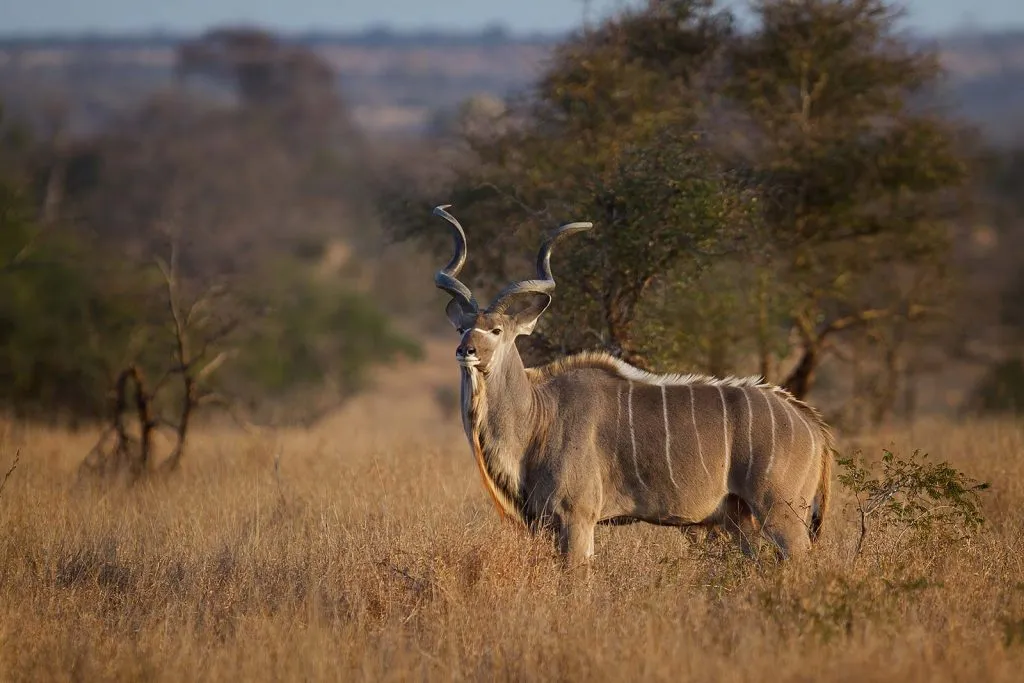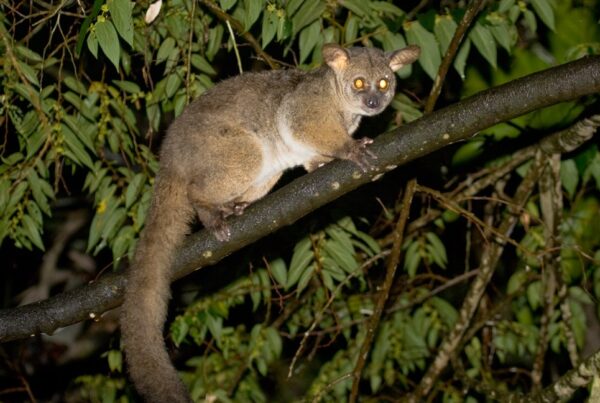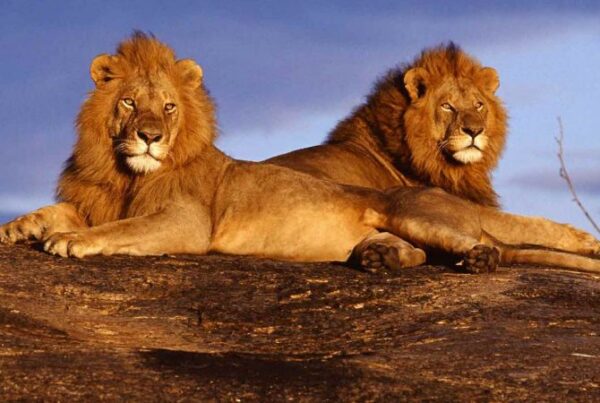5 Fabulous Facts of the Greater Kudu (Tragelaphus strepsiceros)
The Ghost of the Savannah: A Majestic Antelope Unveiled
There are few creatures in the African wilderness that evoke such awe and elegance as the Greater Kudu, a towering and graceful antelope with spiral horns that seem drawn by an artist’s hand. With a presence both subtle and powerful, the Greater Kudu is often referred to as the “ghost of the bush” — not only for its elusive nature but for the way it glides almost silently through thickets and woodland shadows. Unlike the lion or the elephant, whose grandeur is loud and commanding, the Greater Kudu asserts its majesty through a more refined and mystic charisma.
This remarkable antelope is found across various parts of eastern and southern Africa, dwelling primarily in dense woodlands, scrublands, and semi-arid zones. It belongs to the genus Tragelaphus, known for its tall, slender build and ornate horns. The Greater Kudu (Tragelaphus strepsiceros) is the largest of the kudu species and one of the most visually striking antelopes in Africa.
In this detailed exploration, we dive into five fabulous facts that unveil the secrets of the Greater Kudu — facts that not only illustrate the creature’s beauty but also highlight its ecological, behavioral, and evolutionary significance. By the end of this journey, you will see why encountering a Greater Kudu on safari is one of Africa’s most enchanting experiences.
Horns Like Helixes: Nature’s Sculptural Marvel (Facts of the Greater Kudu)
Perhaps the most instantly captivating feature of the Greater Kudu is its majestic spiral horns. These extraordinary structures can grow up to 1.8 meters (6 feet) in length and make up to two and a half full twists. Found only on males, these horns begin to spiral as the kudu matures and serve multiple functions: they are tools for combat, ornaments of sexual selection, and emblems of status within the group.
The curling design of the horns is not merely decorative. In dominance contests, kudu males engage in ritualized battles, locking horns in slow, deliberate tests of strength and leverage rather than violent clashes. These contests rarely result in injury, as the species has evolved mechanisms to avoid serious harm, unlike some other antelopes that fight with lethal intensity.
The horns are also a magnet for admiration from humans. In ancient African symbolism and tribal culture, the horns of the kudu were often considered sacred. Their spirals represented continuity, time, and the unseen patterns of nature — a design echoed in many pieces of indigenous art and ceremonial wear.
These spiraled crowns contribute to the kudu’s ghost-like image, as they glide silently through the trees, their horns slicing elegantly through dappled sunlight. Whether silhouetted against a rising sun or half-hidden in the shade of a mopane tree, the kudu’s horns always leave an impression of awe.
Masters of Camouflage: The Art of Staying Unseen
In the animal kingdom, visibility often means vulnerability. The Greater Kudu has mastered the art of staying invisible in plain sight. With their vertical white stripes — usually six to ten running down the body — and earthy grey-brown coats, they melt seamlessly into the dappled patterns of their woodland environments. These stripes mimic shafts of light filtering through trees, making it difficult for predators to pick out their silhouette against the background.
But camouflage is only half the story. The Greater Kudu is also a master of stillness. When sensing danger, it doesn’t flee immediately. Instead, it will freeze and hold its breath, often going unnoticed even by nearby humans or predators. Only when directly threatened does it burst into action, leaping with astonishing power and speed, capable of clearing fences and obstacles as high as 2.5 meters in a single bound.
This blend of visual stealth and explosive agility makes the kudu a challenging target even for apex predators like lions and leopards. Unlike many antelope species that rely primarily on herd security and panic-driven flight, kudus leverage their solitary or small-group behavior to remain undetected for as long as possible — a trait that makes encounters with them during safari drives feel like rare, intimate discoveries.
A Gentle Giant with Towering Elegance
Though less aggressive and social than other antelopes, the Greater Kudu exudes a quiet majesty. Males can weigh between 190 to 270 kilograms, while females tend to be smaller, averaging around 120 to 210 kilograms. Their height at the shoulder reaches up to 1.6 meters, giving them a tall, regal stature, particularly when viewed head-on in the open savannah.
Unlike the more aggressive and territorial males of some other antelope species, kudu bulls often coexist peacefully, particularly outside the breeding season. They form bachelor groups or remain solitary, wandering through the bush in search of food and safety. Their diet is varied and adaptive; they are primarily browsers, feeding on leaves, shoots, fruits, and sometimes even succulents during the dry season when water is scarce.
Females, on the other hand, tend to form small matriarchal groups, usually comprising a few females and their offspring. The calves are born after a gestation period of around eight months and are hidden carefully in undergrowth for the first few weeks of life. This hiding strategy, coupled with the calf’s innate stillness and camouflaged coat, greatly increases survival rates in areas of high predation.
The Greater Kudu’s lifestyle reflects a delicate balance between boldness and restraint, power and subtlety — a contrast that lies at the heart of its enduring allure.
Vocalists of the Wild: Communication Beyond Sight
While much of the kudu’s survival relies on silence and concealment, it is also among the more vocal antelope species when necessary. It produces a range of sounds, including alarm barks, grunts, low moans, and even snorts, especially during mating season or when warning group members of approaching danger.
One of the most distinct and often startling vocalizations is its alarm bark — a loud, guttural call that echoes through the bush like the bark of a large dog. This bark is used to alert others of danger and is often followed by a flurry of movement or a sharp freeze as the animal reassesses its environment.
Beyond vocalization, kudus also use body language as a primary mode of communication. Ear posture, tail flicks, and the orientation of their head can convey intent or signal alarm. In the mating season, males will display a ritualized posture called the “neck wrestle,” where they face each other with their necks arched and heads low, sizing each other up before locking horns in slow-motion duels.
These behaviors highlight the kudu’s sensitivity and intelligence. They are not just creatures of instinct but of deliberate communication — adapting to changing conditions through layered social signals and nuanced body dynamics.
Guardians of Biodiversity: Ecological Significance in African Ecosystems
Beyond their visual and behavioral appeal, the Greater Kudu plays a critical role in maintaining ecological balance within its habitat. As primary browsers, kudus help manage vegetation growth in wooded and semi-arid ecosystems, preventing overgrowth and facilitating new plant cycles. Their selective feeding also contributes to seed dispersal and pruning of dominant plant species, encouraging plant diversity and regeneration.
Predators, particularly large carnivores like lions, leopards, and hyenas, rely on the kudu as a key part of their diet. The presence of kudu populations is often an indicator of a healthy predator-prey dynamic — a fundamental element of ecosystem health.
Moreover, kudus indirectly support scavenger species. When a kudu falls to predation, vultures, jackals, and other carrion feeders benefit from the remains, ensuring that energy continues to flow efficiently through the food web. Even their dung plays a role, enriching the soil and providing food for dung beetles and other decomposers.
In this way, the Greater Kudu is more than a solitary ghost of the bush. It is a keystone of biodiversity, a quiet yet powerful force that supports the health and function of entire ecosystems across the African continent.
Experience the Magic of the Greater Kudu with WildHorn Africa
There are few creatures more emblematic of the African wilderness than the Greater Kudu. With its spiral horns, spectral grace, and ecological importance, this antelope captures the heart of what a true safari should offer: not just dramatic scenes of predator and prey, but subtle, awe-inspiring moments of natural artistry.
At WildHorn Africa, we believe in crafting safari experiences that are deeply immersive, responsibly curated, and soul-stirring. Whether you’re journeying through the miombo woodlands of southern Tanzania, the thickets of Botswana, or the acacia-strewn landscapes of Namibia, our expert guides will help you track and observe the elusive Greater Kudu — always with reverence, respect, and passion.
Book your African safari with WildHorn Africa today, and step into the wild places where legends roam. Let the horns of the kudu guide your path into mystery, memory, and the heartbeat of Africa.
Facts of the Greater Kudu #Facts of the Greater Kudu Facts of the Greater Kudu





 WildHorn Africa – Authentic and unforgettable tours across Africa, guided by local experts who know the land, wildlife, and culture best.
WildHorn Africa – Authentic and unforgettable tours across Africa, guided by local experts who know the land, wildlife, and culture best.


